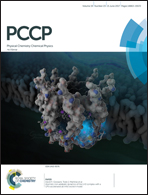Theoretical perspectives on the structure, electronic, and optical properties of titanosilicates Li2M4[(TiO)Si4O12] (M = K+, Rb+)†
Abstract
It is still a challenge to design and synthesize high performance broader ultraviolet non-linear optical (NLO) materials. Two new transition-metal silicates have recently attracted a lot of attention due to their strong phase-matched second harmonic generation (SHG) responses (about 4.5 times higher than KDP). However, the electronic and optical properties underlying the high performance of these materials and consequently, the possibility of designing more efficient silicates for NLO applications are not presently clear. In this study, the geometrical structure and bonding character, electronic structure and optical properties of Li2M4[(TiO)Si4O12] (M = K+, Rb+) crystals have been systematically determined based on the density functional theory. Satisfactory agreement between the experimental and theoretical results indicates that the method and conditions used herein are favorable. A detailed analysis of the precise electronic structure and dipole moments of the two compounds suggests that it is the strong covalent character between Ti(Si) and O and the same orientation alignment of the dipole moment vector of the constituent asymmetric [TiO5]6− square pyramid anion units that result in the large SHG responses for the two compounds. In addition, the unavailable linear and non-linear optical experimental parameters, including dielectric function, optical absorption and birefringence, and all the components of the SHG coefficients are reported for the first time. This investigation unravels the structure–property relationships of titanosilicates and may be significant in terms of providing an efficient strategy towards designing more potential and competitive NLO materials.
![Graphical abstract: Theoretical perspectives on the structure, electronic, and optical properties of titanosilicates Li2M4[(TiO)Si4O12] (M = K+, Rb+)](/en/Image/Get?imageInfo.ImageType=GA&imageInfo.ImageIdentifier.ManuscriptID=C7CP01946G&imageInfo.ImageIdentifier.Year=2017)


 Please wait while we load your content...
Please wait while we load your content...